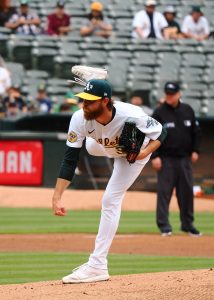Athletics manager Mark Kotsay provided reporters with some injury updates on a few players today, with Matt Kawahara of the San Francisco Chronicle relaying the information. Right-hander Paul Blackburn and catcher Manny Piña have each been slowed down by injuries recently and it’s now unclear if either player will be available to the A’s when Opening Day rolls around.
In Blackburn’s case, he has a fingernail avulsion, or torn nail, on the middle finger of his right hand. He’s playing light catch at the moment but it seems that he can’t do much else and he won’t make his scheduled spring start tomorrow.
The 29-year-old Blackburn is going to be one of the more seasoned pitchers in the A’s rotation this year, at least in terms of major league experience. Shintaro Fujinami and Drew Rucinski are slated for two spots after lengthy showings in Japan and Korea, respectively. Blackburn and James Kaprielian each have just over 50 major league appearances and should also have spots, with another job available to one of the club’s pool of less-established pitchers like JP Sears, Ken Waldichuk, Adam Oller, Kyle Muller or Adrián Martínez.
Blackburn had a nice breakout campaign last year, pitching to a 4.28 ERA over 21 starts. That ERA might not jump out so much, but he had a much lower 2.90 figure through early July. His 18.8% strikeout rate in that time was subpar, but he paired that with a strong 6.2% walk rate and 48.7% ground ball rate. His results took a step back from that point as he dealt with pain in his pitching hand, eventually resulting in a diagnosis of a torn tendon sheath in his right middle finger.
Blackburn was looking to get back on track here in 2023 but it seems he will at least be delayed now due to that same finger. Blackburn tells Kawahara that the current issue is unrelated to last year’s injury. At this point, it’s still not clear if he’ll need to miss some of the start of the regular season, but if he does, it would potentially open up an opportunity for one of those aforementioned pitchers looking to earn a job with the club.
One other pitcher who could have been in that mix but is also facing his own setback is Freddy Tarnok. Kawahara relays that Tarnok is experiencing some right arm discomfort and is shut down from throwing while undergoing testing. At this point, it’s unclear what’s ailing Tarnok or how long he will be out of action, but he’ll be on the sidelines of the rotation competition for the time being. The 24-year-old, acquired in the Sean Murphy trade, made a one-game MLB debut with Atlanta last year. He spent most of the year in Double-A and Triple-A, posting a 4.05 ERA over 106 1/3 innings.
As for Piña, Kotsay says he “felt something” in his left wrist and will be evaluated. He signed a two-year deal with Atlanta last year but was shut down in May with surgery on that left wrist, limiting him to just five games on the year. The A’s brought him over in the Murphy deal to serve as a veteran complement to rookie Shea Langeliers, who is going to take over Murphy’s job as the primary backstop in Oakland. At this point, it’s unknown how significant this issue is for Piña, but it will be noteworthy to watch for the A’s as he and Langeliers are currently the only two catchers on the 40-man roster. If Piña does end up needing to miss some time, that would create an opening for a non-roster invitee, with Kotsay naming Yohel Pozo or Kyle McCann as potential options. When asked about prospect Tyler Soderstrom, Kotsay had this to say: “I think Tyler could handle himself. I also think from a polished, development side for Tyler, I think it would be a bit rushed. But not to exclude him in the process.”
